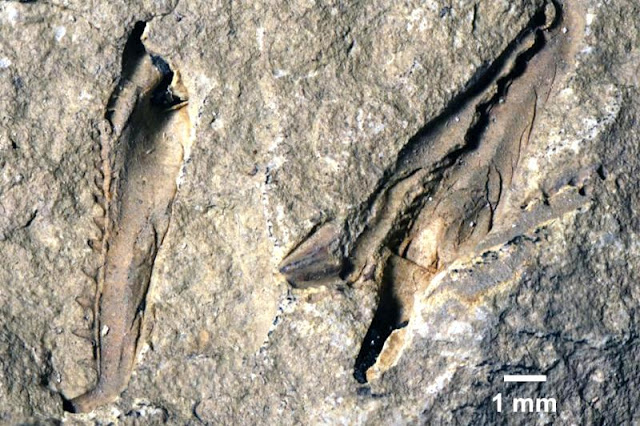Scientists uncover P-meter lengthy carnivorous WORM with snapping jaws
 |
| This is a photograph displaying the holotype of Websteroprion armstrongi. |
Gigantic Worm With Snapping Jaws Lived four hundred Million Years Ago
A beforehand undiscovered species of an extinct primordial big worm with terrifying snapping jaws has been recognized by a world group of scientists.
Researchers from the University of Bristol, Lund University in Sweden and the Royal Ontario Museum studied an historic fossil, which has been saved on the museum because the mid-Nineteen Nineties, and found the stays of an enormous extinct bristle worm (the marine family members of earthworms and leeches).
The new species is exclusive amongst fossil worms and possessed the most important jaws ever recorded in this kind of creature, reaching over one centimetre in size and simply seen to the bare eye. Typically, such fossil jaws are just a few millimetres in measurement and have to be studied utilizing microscopes.
Despite being solely is aware of from the jaws, comparability with dwelling species means that this animal achieved a physique size in extra of a metre.
This is similar to that of ‘big eunicid’ species, colloquially known as ‘Bobbit worms’ that are fearsome and opportunistic ambush predators, utilizing their highly effective jaws to seize prey comparable to fish and cephalopods (squids and octopuses) and dragging them into their burrows.
Lead writer Mats Eriksson from Lund University stated: “Gigantism in animals is an alluring and ecologically necessary trait, often related to benefits and aggressive dominance.
“It is, nevertheless, a poorly understood phenomenon amongst marine worms and has by no means earlier than been demonstrated in a fossil species.
“The new species demonstrates a singular case of polychaete gigantism within the Palaeozoic, some four hundred million years in the past.”
Co-writer Luke Parry from the University of Bristol’s School of Earth Sciences, added: “It additionally exhibits that gigantism in jaw-bearing polychaetes was restricted to at least one specific evolutionary clade inside the Eunicida and has advanced many occasions in several species.”
The specimens have been collected over the course of some hours in a single day in June 1994, when Derek N Armstrong of Ontario Geological Survey was dropped by helicopter to research the rocks and fossils at a distant and short-term publicity in Ontario.
Sample supplies, from what proved to belong to the Devonian Kwataboahegan Formation, have been introduced again to the Royal Ontario Museum, the place they’ve been saved till they caught the eyes of the authors’.
avid Rudkin from the museum stated: “This is a wonderful instance of the significance of wanting in distant and unexplored areas for locating new thrilling issues, but in addition the significance of scrutinizing museum collections for ignored gems.”
The species has been named Websteroprion armstrongi. This honours Armstrong, who collected the fabric, and bass participant extraordinaire, Alex Webster of Death Metal band Cannibal Corpse, since he may be considered a ‘big’ on the subject of dealing with his instrument.
Luke Parry added: “This is becoming additionally since, beside our urge for food for evolution and paleontology, all three authors have a profound curiosity in music and are eager interest musicians.”
The above publish is reprinted from Materials offered by University of Bristol.